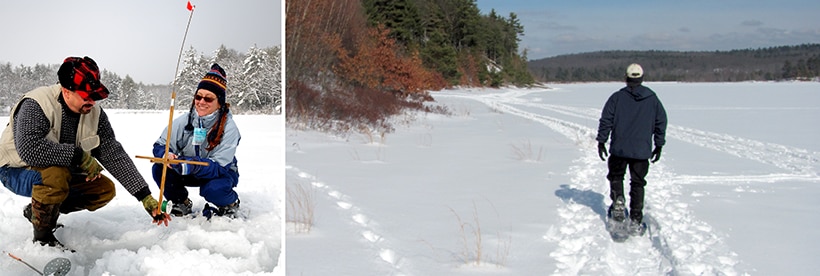How can you tell if ice is safe?
There are no guarantees. Always consider ice to be potentially dangerous. You can't judge ice conditions by appearance or thickness alone; many other factors like water depth, size of waterbody, water chemistry, currents, snow cover, age of ice, and local weather conditions impact ice strength.
Ice tips to remember:
- New ice is stronger than old ice. Four inches of clear, newly formed ice may support one person on foot, while a foot or more of old, partially thawed ice may not.
- Ice doesn't freeze uniformly. Continue to check ice conditions frequently as you venture out onto the ice.
- Ice formed over flowing water and currents is often more dangerous. Avoid traveling onto ice-bound rivers and streams, as the currents make ice thickness unpredictable. Many lakes and ponds may contain spring holes and other areas of currents that can create deceptively dangerous thin spots.
Video: MassWildlife ice safety video
Skip this video MassWildlife ice safety video.Before heading out onto the ice
- Tell someone your plans, including where you are going and when you expect to return.
- Come prepared. Carry a cell phone in case of emergency. Always carry ice picks and rope with you on the ice. In case of emergency, drive the nails into the ice and pull yourself to safety while kicking (see tips for falling in below).
- Wear your life jacket. If you fall in, a life jacket will keep you at the surface and can provide insulation against the effects of cold water.
Ice thickness guidelines
The guidelines below are for clear, blue ice on lakes and ponds. White ice or snow ice is only about half as strong as new clear ice and can be very treacherous. Use an ice chisel, auger, or cordless drill to make a hole in the ice and determine its thickness and condition. Bring a tape measure to check ice thickness at regular intervals.
| Ice Thickness (inches) | Permissible Load (on new clear/blue ice on lakes or ponds) |
|---|---|
| 2" or less | STAY OFF! |
| 4" | Ice fishing or other activities on foot |
| 5" | Snowmobile or ATV |
| 8"–12" | Car or small pickup truck |
| 12"–15" | Medium truck |
Falling through the ice
If you fall in:
- Don't panic: Call for help if there are people nearby.
- Don't remove winter clothing: Air trapped in your clothes can provide warmth and help you float.
- Turn the direction you came from: Ice you previously walked on should be the safest.
- Place your hands and arms on an unbroken surface and kick your legs: If you have ice picks or a pair of nails, use them to pull yourself up onto the ice while kicking.
- Lie flat and roll away: Once your torso is on firm ice, roll toward thicker ice to distribute your weight.
- Find shelter and get warm: Change out of wet clothing and find warm, dry coverings.If you are in a remote area, get to or start a campfire. Otherwise, get to a car or house. Seek medical advice from your physician on medical attention.
If someone else falls in:
Remember the phrase "Preach-Reach-Throw-Go."
- Preach: Call 911 if you can. Shout to the victim to reassure them help is on the way.
- Reach: If you can safely reach them from shore, extend an object like a rope, jumper cables, tree branch, or ladder to them.
- Throw: Toss one end of a rope or something that will float to the victim.
- Go: If the situation is too dangerous for you to perform a rescue, call 911 or go to find help. Untrained rescuers can become victims themselves.
If a pet falls in:
Do not attempt to rescue the pet, go find help. Well meaning pet owners can easily become victims themselves when trying to assist their pets. Remember to always keep pets leashed while walking on or near ice.
